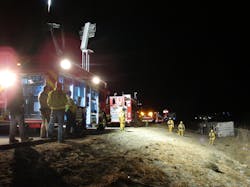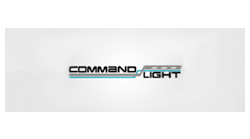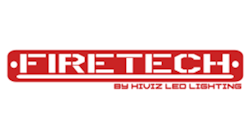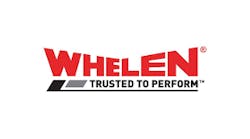Apparatus Scene Lighting is All About Getting Light Where it's Needed
When it comes to apparatus scene lighting, experts are unanimous saying the most important light is usable light and that it gets to where it’s needed.
Apparatus can have lamps bolted all over the place, but if it’s not the right kind of light or not able to hit the desired targets, firefighters will be in the dark, literally.
Three experts in the scene lighting field shared their thoughts with Firehouse about lighting, the science behind it and how to make the best decisions when it comes to specifying apparatus lighting.
“If you can draw a radius around the apparatus with light, with a couple on the sides, a couple in the back and a brow light on the front, and you can light it well enough to do your work, you’re doing well,” said Sam Massa, president and owner of Lillington, NC-based HiViz LED Lighting/Firetech.
Massa also said lighting should be able to hit a scene, like a structure fire, that might be a hundred yards away.
“Where you need the light most is where you’re working,” Massa said.
Roger Weinmeister, president of Command Light, agrees.
“The whole thing about lighting is to make sure it’s useable,” said Weinmeister. Command Light, based in Fort Collins, CO, makes mechanisms that help elevate the light heads above the apparatus and direct light at where it is needed most.
Weinmeister said apparatus traditionally has been served by four pole-mounted lights on each corner of the body. “Nobody wants to be putting those pole lights up,” he said. “You put up one or two of those and go do something fun.”
A tower, according to Weinmeister, can help eliminate that chore. A small tower with four light heads can help get all four lights pointing at the scene in 15 seconds for about the same cost as four individual light heads on poles, he said, adding that elevation helps spread the light better and get it where it’s needed most.
“You should get the light up off the apparatus a little bit,” Weinmeister said. “You don’t need 30 to 40 feet, but just enough so when you look back at the apparatus, you’re not causing light blindness.”
When it comes to the type of lighting available, the standard for decades has been quartz halogen on a pole mounted to the apparatus. But in the last five years or so, that has changed dramatically.
Today, the overwhelming trend is toward LED lighting, which stands for light-emitting diode, a small electronic, two-lead semiconductor that illuminates when charged with electricity. They can be powered by AC or DC current and combined in an almost infinite array of designs and numbers.
“Everyone wants LEDs,” Massa said, noting that his company is in the off-road lighting market as well as mining and industry. It more recently joined the fire service market, which Massa, who is a firefighter and EMT, said is very different than other markets.
“The fire service has very different needs,” Massa said. “It’s such a foreign market to the rest of the world.” That’s why he and his company have spent extensive time studying current fire service lighting needs.
“The only constant in the fire service is the fire truck and the guys riding in it,” Massa said. “What you are trying to illuminate changes with every single call. There are so many variables that you have to plan for everything. Half the calls, or more, are at night and the lights have to be designed for rescue and for use in structure fires.”
To achieve those diverse lighting needs, Massa said his company can render, with computer modeling, grids around apparatus to realistically illustrate the amount of illumination departments can expect from the lights they choose. They have created a resource guide to help firefighters select the proper scene lights, which can be found on the company's website.
“The truck is the constant,” Massa said, noting the light measurements are taken at the source and at the target, which is the object to be illuminated. He said the units measured are lux and lumen, two standard units of lighting. Lumens are the measurement of light close to the single source and lux is light that hits the targets.
To put the lumens to lux concept in firefighters’ terms, Massa used a handline analogy. A firefighter with a nozzle at 250 gpm with a full fog pattern on will throw a lot of water a very short distance. The gallonage going through the nozzle is the equivalent of lumens. The pattern and focus of the light is like changing the nozzle from a fog pattern to cover a large area close to the firefighters and the straight stream will hit targets further away. Those patterns and targets are controlled by optics, he said.
Interestingly, until just Jan. 1 of this year, there were no uniform standards to rate fire service lights, Massa said, noting the National Fire Protection Association (NFPA) just adopted standards. Prior to the standard, claims of lighting power were largely “marketing bravado” and “wildly outside the norms,” Massa said.
The advantage of having NFPA standards is it allows firefighters to make meaningful comparisons when choosing lights.
“It gives firefighters the authority to ask for documentation from the manufacturer,” Massa said.
Weinmeister said the introduction of LEDs to the fire service has “blown wide open” the options for lighting on apparatus. “You can have lots of lights without a generator,” he said. “But they are not cheap.”
He said fire departments will have to make a decision about whether to go with quartz lights or High-Intensity Discharge (HID) or LED lights. The more traditional quartz and HID lights typically need a generator, he said, noting that they are a fine choice if the department has other needs for a generator.
But, if a generator is not needed for other uses, departments should go with LED lights, Weinmeister said, noting that there’s apparatus space savings realized by removing a generator.
“You may end up spending as much as you would if you bought a generator, but (LEDs) are cleaner, easier to use and you gain space in the dunnage area,” Weinmeister said.
Massa said another huge advantage of LED lighting is the efficiencies realized. Massa, who said 90 percent of his business is in LED lighting, said LEDs are very good at converting energy to light, as much as 10 to 50 times better depending on the light and the optics.
“With the same power, you can produce significantly more light, or you can produce the same light with less power,” Massa said. “That’s the biggest benefit.” And, LEDs typically have a 50,000-hour life span, which he said is theoretically the life of the apparatus.
Dan Korcak, a sales engineer for Chester, CT-based Whelen Engineering, who has worked for the company 31 years, said he has seen the evolution from quartz halogen to the company’s Pioneer LED lighting.
“The big advantage is amp draw,” Korcak said. “Between halogen and LED, there’s a big difference.”
He said one thing to keep in mind is LEDs have to be optically controlled with reflectors and lenses to maximize the lighting.
LED light fixtures also offer lighting that most closely resembles that found on a bright, summer sunny day on the Kelvin color temperature range.
“They produced a white bright light,” Korcak said. “That’s what makes the LED so much brighter.”
Korcak explained that a 150-watt LED light is extremely bright, noting that number might sound very low when firefighters see numbers like 750-watt and 1,000-watt quartz halogen and HID lights.
He explained that quartz halogen and HID lights cast lighting that has a “dingy brown cast, like that found at sunrise, or just before sunset. LED light is like looking at a white piece of paper as opposed to a piece of tan paper.”
Korcak said LED light is pure, monochromatic light that points to one source, which needs to be collimated or accurately aligned efficiently with angling optics to point vertically and horizontally. He said Whelen uses Lexan and Polycarbonate materials for lenses and optics, which are state of the art, but can cause up to 40 percent loss of raw light produced by the LEDs. He further explained that the numbers after the optics and lenses have been employed are the numbers Whelen puts in product information sheets and markets.
“Optics are something we’re very good at,” Korcak said. “LEDs have really taken off. They keep refining them and they are so much better now. We always stay on the leading edge of that technology."









